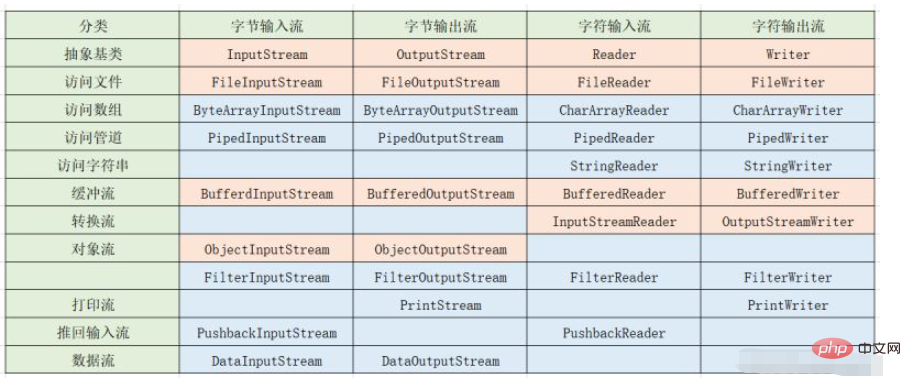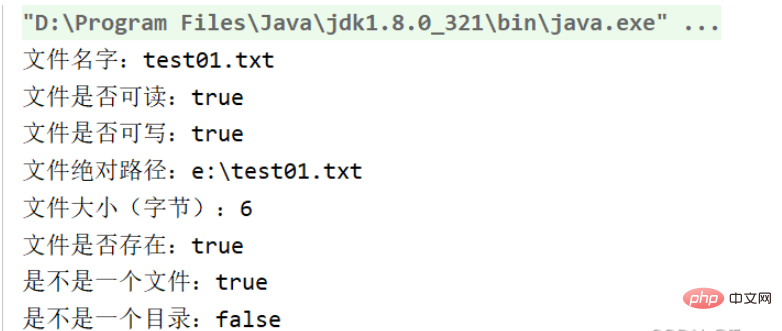
I/O是Input和Output的缩写,I/O技术是非常实用的技术,用于处理数据传输(如:读/写文件,网络通信)
Java程序中,对于数据的输入/输出操作是以流(stream)的方式进行的
java.io包下提供了各种流(stream)类和接口,用以获取不同种类的数据,并通过方法输入和输出数据。
文件流:文件在程序中是以流的形式操作的

输入流:数据从数据源(文件)到程序(内存)的路径
输出流:数据从程序(内存)到数据源(文件)的路径
按操作数据单位分为:字节流(二进制文件)、字符流(文本文件)
按数据的流向分为:输入流、输出流
按流的角色分为:节点流、处理流
| 抽象基类 | 字节流 | 字符流 |
|---|---|---|
| 输入流 | InputStream | Reader |
| 输出流 | OutputStream | Writer |
♨️I/O的体系结构

什么是文件?
文件,对于我们并陌生,文件就是保存数据的地方,比如word文档、txt文本、excel文件、图片、视频…等都是文件,操作系统中以文件为单位管理磁盘中的数据。从数据存储角度来说,所有文件本质上都是一样的,都是由一个个字节组成的归根到底都是0-1比特串。
文件夹(目录)
多个文件如果不分类放在一起,用户使用起来就非常不方便,因此,又引入了树形目录(也叫文件夹)的机制,可以把文件放在不同的文件夹中,文件夹中还可以嵌套文件夹,这就便于用户对文件进行管理和使用。
创建文件对象相关构造器和方法
new File(String pathname);//根据路径构建一个File对象
new File(File parent,String child);//根据父目录文件+子路径构建
new File(String parent,String child);//根据父目录路径+子路径构建
createNewFile();//创建新文件
在E盘下,用以上方式创建文件test01.txt\test02.txt\test03.txt
import java.io.File;
import java.io.IOException;
public class FileCreate {
public static void main(String[] args) throws IOException {
//方式1
String pathname = "e:\\test01.txt";
File file1 = new File(pathname);
file1.createNewFile();
//方式2
File parentfile = new File("e:\\");
String child2 = "test02.txt";
File file2 = new File(parentfile, child2);
file2.createNewFile();
//方式3
String parent = "e:\\";
String child3 = "test03.txt";
File file3 = new File(parent, child3);
file3.createNewFile();
}
}
获取文件的相关信息
get.getName();//获取文件名字
canRead();//文件是否可读
canWrite();//文件是否可写
getAbsoultePath();//获取文件的绝对路径
getPath();//相对路径
getParent();//获取文件父级目录
lenth();//文件大小(字节)
exists();//判断文件是否存在
isFile();//判断是不是一个文件
isDirectory();//判断是不是一个目录
import java.io.File;
public class FileInfomation {
public static void main(String[] args) {
//创建文件对象
File file = new File("e:\\test01.txt");
System.out.println("文件名字:" + file.getName());
System.out.println("文件是否可读:" + file.canRead());
System.out.println("文件是否可写:" + file.canWrite());
System.out.println("文件绝对路径:" + file.getAbsolutePath());
System.out.println("文件大小(字节):" + file.length());
System.out.println("文件是否存在:" + file.exists());
System.out.println("是不是一个文件:" + file.isFile());
System.out.println("是不是一个目录:" + file.isDirectory());
}
}
文件比较
File f1=new File("D:\\test1.txt");
File f2=new File("D:\\test2.txt");
f1==f2;//比较的是两个对象的地址
f1.equals(f2);//比较两个对象对应的文件的路径目录操作和文件删除
mkdir();//创建单层目录
mkdirs();//创建多层目录
delete();//删除目录(这层目录必须为空,没有内容)
查看文件目录
list();//返回一个字符串数组,命名由此抽象路径名表示的目录中的文件和目录。
listFiles();//返回一个抽象路径名数组,表示由该抽象路径名表示的目录中的文件。
案列:遍历一个目录下的所有文件打印输出
public class PrintFile {
public static void main(String[] args) {
//创建文件对象
File file = new File("e:\\Test");
String[] list = file.list();//文件夹下目录/文件对应的名字的数组
for (String s : list) {
System.out.println(s);
}
File[] files = file.listFiles();
for (File f : files) {
System.out.println(f.getName() + "," + f.getAbsolutePath());
}
}
}
遍历目录
1.给定一个文件对象file
2.listFiles()获取该文件下的所有文件对象数组
3.遍历File对象数组,如果是目录,递归调用该方法获取该目录下的所有文件对象;如果是文件,打印输出路径+姓名
import java.io.File;
public class PrintFile {
public static void main(String[] args) {
File file = new File("E:\\Code");
getAllFile(file);
}
public static void getAllFile(File file) {
//获取给定目录下的所有File对象数组
File[] files = file.listFiles();
//开始遍历
if (files != null) {
for (File f : files) {
if (f.isDirectory()) {//判断是否为目录,如果是,调用递归
getAllFile(f);
} else {//不是,就打印路径+文件名
System.out.println(f.getAbsoluteFile() + "下的:" + f.getName());
}
}
}
}
}The above is the detailed content of Java basics: I/O streams and File class file operation methods. For more information, please follow other related articles on the PHP Chinese website!




